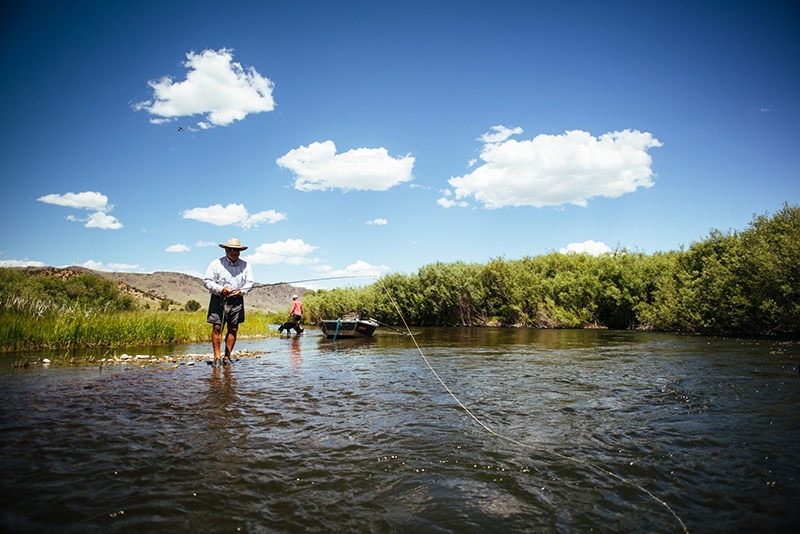
Writing blog posts for TU’s website:
Congratulations on your decision to craft a blog post for TU’s website. Good blog posts are conversational, lively and explanatory without being too heavy. While there are no general length requirements, they should be quite short—shoot for 300 to 500 words. Longer-form items can be posted, but they require more time to edit and schedule. For most blog posts, where we endeavor to explain our work to a general fishing/conservation audience, the tighter the better.
AP Style generally applies to blog posts (with some notable exceptions), but inverted pyramid style does not. Blog posts should be written with some personality. We use AP Style for several reasons:
- If other news outlets choose to “pick up” or reprint a blog post, it will already be in the appopriate style.
- AP Style is the accepted standard for media outlets, both in print and online.
- It keeps us consistent with our press outreach materials (press releases, advisories, statements, etc.).
Creativity matters, as does the inclusion of photos, videos and other elements (links, graphs, charts, pull quotes, etc.). Don’t be afraid to use first-person references, particularly if you’re writing from a position of authority. Blog posts offer us the ability to tell our story as we see it, from our perspective as conseravationists, trout bums, policy wonks, science nerds, etc. Strive to make them interesting—use humor, be self-depracating and don’t use all those big words you learned in grad school. Pretend you’re writing for an audience that has a general understanding of the work you’re doing, but is easily distracted. Nothing will cause folks to leave the blog post like the inclusion of a little Latin or the use of exhaustive figures that include decimal points and such. Your work is interesting to you, right? Make it interesting to others.
A few specifics:
- Headlines: Headlines should be short and as descriptive as possible to ensure the bulk of the hed is visible when/if the post is elevated to the front of TU.org. To get the most of Google and other search engines, your headline should include key words that are found in your blog post (more on key words shortly). AP Style applies to both heds and body text. Headlines should attract readers to ensure they at least read the first sentence of a blog post. Example, using AP style:
- CORRECT: TroutBlitz helps TU catalog wild trout population.
- INCORRECT: TroutBlitz Helps TU Catalog Wild Trout Populations.
- Bylines: When possible, include a byline for all blog content. Blog posts will automatically show who posted the content, but that’s not always who wrote the content. Bylines should be written in bold text. (e.g. By Matt Barney).
- Photo cutlines and photo bylines: Every photograph should have a cutline and byline (unless the photo is a “file photo”). Our cutline font is Arial, size 12. Cutlines should be short and descriptive. They should be placed below a photograph and put in italics to set them off from body text. A “return” or line break should be added between a cutline and the body text. Photo cutlines should be in italics and justified to the right (if you’re not sure how to do this, don’t sweat it. That’s what editors are for). When possible, they should identify the photographer, the content of the photo and the location of the photo. For example:
- Redband trout, Rogue River, Ore. Photo by John McMillan
- Taglines: When possible, we should identify the author by his/her title and his/her location in a tagline at the end of a blog post. It should be in italics. For example
- Matt Barney is a senior programmer for the Trout Unlimited Science Team. Matt works out of TU’s Boise office.
- Body text: Again, AP Style must be adhered to. Additionally, please put only one space between the period at the end of one sentence and the first letter of the first word of the next sentence. Our body text font is Arial, and our default size is 14 points.
- Punctuation:
- Commas should be used between list words but not after the last word in the list, (i.e., “cheese, crackers, tomatoes, carrots and toast,” not “cheese, crackers, tomatoes, carrots, and toast). In other words, ditch the Oxford comma, please.
- Exclamation points? As a rule, don’t use them. Ever.
- Watch your contractions and make sure you have it right, (i.e., it is becomes it’s. “Its” is possessive, not a contraction; “you are” becomes “you’re,” not “your.” “They are” becomes “they’re,” not “there” or “their,” etc.)
- Numbers: As a rule, spell out all numbers one through nine. Use numerals for 10 and up. Exceptions are for distance and other metrics (“It was a 6-mile hike,” or “she’s a 4-year-old toddler,” or “I fish with a 6-weight rod”). When talking about really BIG numbers (over a million), spell out “million,” (i.e. “There are 64 million acres of roadless land in the West.”). For numbers in the thousands, use a comma to separate to the thousandth, (i.e. 4,500, 12,500, 125,765).
- Capitalization: Capitalize all proper names. This can be tricky in the fish world. For instance, Bonneville cutthroat trout is capitalized, as is Yellowstone cutthroat trout. The term west slope cutthroat is not capitalized, nor is rainbow trout, brown trout, greenback cutthroat trout, mountain whitefish, eastern brook trout, etc. Salmon can be tough, too. For instance, pink, chum, chinook (king), coho are not capitalized. Pacific salmon would be capitalized, as would Atlantic salmon. Proper names/nouns are always capitalized.
- Pronouns. Please make sure you know how people choose to be identified, whether it be by gender or preference. Some prefer to be identified by plural pronouns (their, them, they, for instance), while others choose to be identified by their gender (his, him, her, hers). As we strive for equity and inclusiveness at TU, this matters.
- State names. We’re not the Post Office. Use AP Style for states. For example, California is Calif., not CA. Colorado is Colo., not CO. Montana is Mont., not MT. Maine is … Maine, not ME. Idaho is … Idaho, Not ID. Minnesota? Minn. Wisconsin? Wisc. Remember: If you’re not referencing a city within the state, then spell out the state completely. (Right:“I hear there are some big trout in Montana.” Wrong:“I hear there are some big trout in Mont.” Right:“There are big trout in Missoula, Mont.” Wrong:“There are some big trout in Missoula, Montana.”)
- Photos and video. It’s very easy to upload photographs in the TU blog interface. Videos are more nuanced, and it’s OK if you need a hand with that. But not just any photo will work. We want good stuff, whenever possible. Remember the “rule of thirds,” where your image is essentially divided into three equal sections. Subjects should be looking into the photo and not perfectly centered. Each “third” should have some visual appeal. As a rule, use straight horizons, be meticulous about your focus and include people in your photos whenever possible. The best advice? Take a lot of photos. The more you take, the better the chances are that you’ll get one that works really well. Please also name your photographs rather than letting your camera name them for you. For instance, “IMG_2003008933” should read “Sunset-Rio-Grande-River-New-Mexico.jpg.” Please use key words when identifying photographs to help Google and other search engines find your work (see below). When inserting photos into our WordPress blog platform, you can also insert “Alt text.” This is a simple description of your photograph that shows up on browsers and mobile devices that have the image settings turned off to preserve data. It can be a simple description. A photo of a brook trout might read, “A brook trout caught in upstate New York.”
- Key words and tagging: Please tag all blog posts with pertinent key words that apply to the blog post and to your photos. Key words are descriptive words that appear naturally and organically (don’t “stuff” your blog full of key words — that’s bad form) several times throughout the blog post. For instance, if the blog post is about steelhead fishing in Washington, good key words would be:
- Washington
- Steelhead
- Fishing
- Fly fishing
- Trout Unlimited
These are just a few items to get you started. The more you write, the better you’ll get. And, the more you write, the more your work will be featured on TU’s website and on our robust social media pages.
Questions: Contact Kara Armano (kara.armano@tu.org). She’s the keeper of the keys to the blog with a detailed understanding of AP style. She’ll be happy to help.


